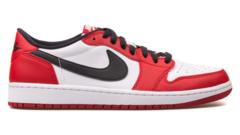The Nike Air Jordan 1 sneaker, a standout staple in American footwear, is often at the intersection of high consumer demand and the complexities of international trade. Originally designed for basketball legend Michael Jordan, this sneaker not only holds cultural significance but also represents the financial challenges that arise from U.S. tariffs targeting foreign imports.
President Donald Trump’s recent tariff initiatives on goods imported from key manufacturing countries like Vietnam, Indonesia, and China have cast a shadow over Nike. With current tariffs ranging significantly between 32% and 54%, many expect these increased costs to affect retail prices for consumers.
Following the announcement of these tariffs, Nike's stock experienced a sharp decline of 14%, indicating market anxiety over the potential disruption to Nike’s supply chain and pricing strategies. Analysts are closely monitoring how much of this cost burden will be transferred onto consumers in the form of higher prices.
Research from UBS projects a price increase between 10% and 12% for Nike's goods sourced from Vietnam, where a significant portion of its footwear production is concentrated. The consensus is that given the extensive nature of the tariffs, particularly on a wide variety of imported shoes, brands will have few alternatives but to raise prices.
Experts suggest that while moderate price hikes are anticipated, the competitive landscape of the sneaker market may limit Nike's ability to raise prices substantially without affecting demand. Morningstar analyst David Swartz notes that a price increase exceeding 10-15% could discourage buyers, reflecting the high stakes that arise from operating in such a competitive area.
Other brands, such as Adidas and H&M, are also grappling with similar issues, facing the necessity of navigating price adjustments while maintaining consumer appeal. Despite generating around $51 billion in sales, Nike's profit margins stand at just about 11% after accounting for various operational costs.
Alternative strategies for maintaining price stability could involve adjustments to product specifications. Industry experts like Rahul Cee propose that Nike could lower costs by opting for less advanced materials or extending product design cycles to minimize expenses.
Market analysts believe that while these tariffs create an immediate challenge, some firms are reserving judgment on their overall impact as negotiations progress. The ongoing tension between the U.S. and China adds layers of urgency for Nike, as the American market significantly contributes to the company’s revenue.
The sentiment among U.S. consumers, which is a vital driver for Nike’s sales—amounting to approximately $21.5 billion—also poses a significant concern for the company. With consumer confidence wavering over price increases and tariffs, many anticipate that Nike might not have the latitude to impose excessive price hikes without jeopardizing market share.
If the current tariff disputes continue unresolved, it is plausible that Nike will be compelled to pass increased sourcing costs onto consumers, with little recourse for absorbing such substantial financial shifts.
While President Trump's administration aims to incentivize American manufacturing, experts contend that the complexity of shoe production means Nike is unlikely to make drastic changes to its supply chains in the foreseeable future. Transitioning manufacturing to U.S. facilities would necessitate considerable investment and restructuring, a process viewed as both lengthy and resource-intensive.
As the situation unfolds, Nike's adaptability to these financial pressures could very well dictate the future dynamics of its product pricing and overall market performance.


















